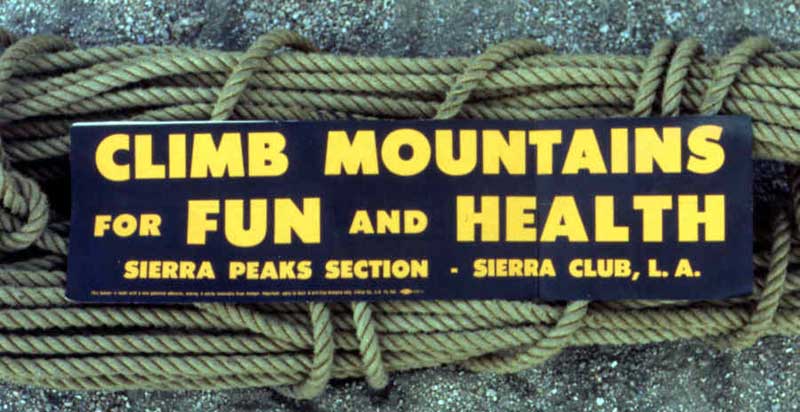The need for a separate
section of the Angeles Chapter of the Sierra Club devoted to hiking, camping
and climbing in the Sierra was evident to many for several years. Base campers,
High Trippers and the Desert Peaks Section had for many years sponsored and
scheduled trips into the Sierra, but it was apparent that the mountains which
inspired the birth of the Sierra Club deserved a section devoted exclusively to
their exploration, protection and enjoyment. The advent of modern paved
highways and fast cars made it as practical to consider conducting weekend
hikes into the Sierra as far north as Bridgeport as it was to hike into the
Angeles Crest area.
Beginning
in 1952, non-scheduled
trips into the Sierra
were conducted with
ever-increasing frequency
by an ever-growing
number of enthusiasts.
Impetus was given this
movement by the fact
that the Desert Peaks
Section scheduled an
average of only three
hikes per year into
the Sierra. This was
felt to be a waste
of many fine weekends
from May through October.
By 1955, the non-scheduled
trips outnumbered scheduled
ones about six to one. |
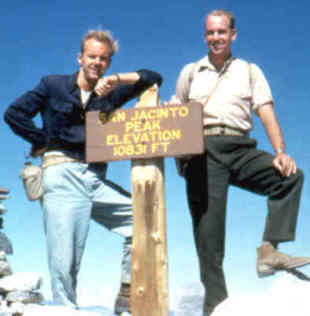
John W.
Robinson (left) and Frank Sanborn (right)
on summit of San Jacinto Peak c.
mid-1950s. |
|

Chuck
Miller on SPS trip to North Palisade
September 6 1959 |
Such long-term Sierra
enthusiasts as Bob Sheller, Miles Brubacher, Barbara Lilley, Lee Owings, Owen
Blackburn, Frank Bressel, Pat Meixner (Gentry), Chuck Miller, John Robinson,
Bud Bingham and Frank Sanborn decided that the time was ripe to organize the
Sierra Peaks Section.
The most essential step, of course, was to draft a
set of by-laws, a statement of purpose and a list of emblem and qualifying
peaks. An interim slate of officers had to be selected to guide the affairs of
the section until the first regular election could be held. Finally, official
recognition and approval by the Chapter Executive Committee had to be
obtained.
Frank Sanborn was selected as the first chairman of the SPS,
Bob Sheller the vice chairman, Pat Meixner the secretary, Leo Scotti the
treasurer and Frank Bressel the alternate officer. Miles Brubacher headed the
first mountaineering committee. |
|
Late in July, 1955, Frank,
Chuck and Pat went before the Executive Committee, informed it of the intent to
organize the section and requested official permission to form the SPS. After
due deliberation, the Executive Committee granted official permission to
organize within the framework of the Sierra Club. Thus the Sierra Peaks Section
was formally launched on its highly successful career under the initial
direction of the above-named people. The first list of emblem and qualifying
peaks was drafted and approved by the Management Committee, and the previously
drafted by-laws were approved and put into force.
By the end of 1955,
the section had 38 members, and monthly business meetings were being held at
the Sierra Club headquarters in downtown Los Angeles. These meetings have been
well-attended from the beginning and attest to the interest and activity of
section members. |
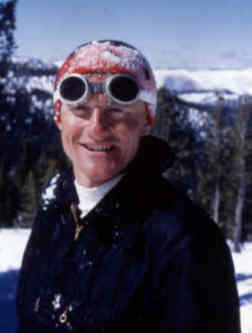
Miles
Brubacher
Mammoth Mountain. 1958 |
|
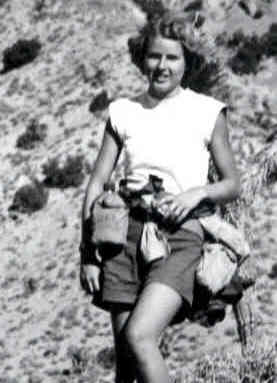
Barbara
Lilley near Avawatz Peak
November 15 1950 |
One of the main purposes of
the section was, and is, to schedule weekend trips into the Sierra for the
purpose of familiarizing Sierra Club members and others with California's
premier mountains and fostering comradeship among those interested in this
activity. Enjoyment of, as well as knowledge of, the trails, peaks, meadows,
campsites, lakes, streams, forests, valleys and wildlife of the Sierra has been
of primary interest.
The original 12 emblem peaks were from south to
north, Olancha Peak, Kaweah Peak, Mt. Whitney, Mt. Williamson, Mt. Brewer, Mt.
Sill, Mt. Goddard, Mt. Darwin, Mt. Ritter, Mt. Abbot, Mt. Lyell and Matterhorn
Peak. |
|
The present emblem of the SPS
was drawn up by Bud Bingham in March, 1956, and promptly adopted. A beautiful
piece of work, it shows the distinctive emblem peak, Mt. Williamson, in
profile, with white Sierra summer clouds floating overhead, snow on the flanks
and pine boughs intertwined underneath. The climbing of the 10 emblem peaks
entitled a member to wear the emblem of the section. By the end of 1956, the
section boasted 18 emblem holders.
By the late fall of 1956, the
section was well established. Some by-law changes had been proposed and adopted
by the membership, the monthly meetings were well attended and committees on
social affairs and safety were being set up or discussed. Membership had more
than doubled from the previous December, with a total of 62
enrolled. |
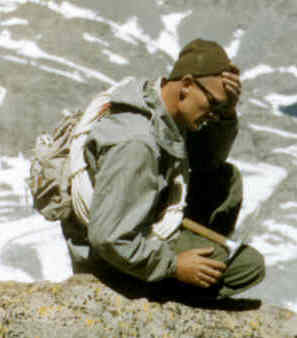
Bud Bingham
on SPS trip to Sill
July 27 1958 |
|
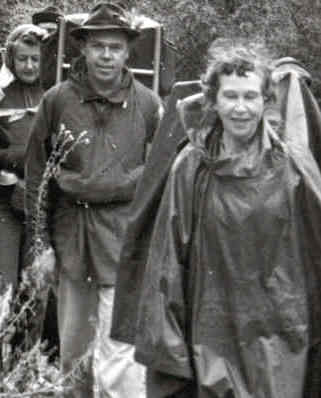
Roger
Gaefcke hiking behind Bea Wheelock
in the rain, Palm Canyon February 29,
1959 |
The officers who guided the
affairs of the section through 1955 and 1956 felt that the time had now come
for the first of what were to be annual elections. Candidates for the various
management offices were listed, and balloting was conducted by mail. As a
result of this first full election, the following persons were elected to guide
the affairs of the section in 1957: Bud Bingham, chairman; John Robinson, vice
chairman; Barbara Lilley, secretary; Pat Meixner, treasurer; and Frank Sanborn,
alternate officer. This group officially took over the management of the
affairs of the section in January, 1957. It had been decided earlier that no
officer could be re-elected for a second consecutive year in the same post.
Chuck Miller became head of the Mountaineering and Schedule Committee.
In 1956, the section began its main function, that of scheduling weekend trips
into the Sierra. The first scheduled SPS trip was led by Frank Sanborn and John
Robinson, to Deer Mountain, near the South Fork of the Kern River, on May 5-6,
1956. On May 26-27, Frank Sanborn and Miles Brubacher took an SPS group to
Maggie Mountain, in the Balch Park area east of Porterville. George Wallerstein
and Steve Wilkie led a trip to Mt. Gilbert, back of South Lake, on June 2-3.
Frank Sanborn and Ted Maier took a group to Trail Peak in Cottonwood Basin on
June 9-10. On June 23-24, Don Clarke and Bud Bingham led an assault on the
northernmost emblem peak, 12,281-foot Matterhorn Peak, in northern Yosemite
west of Bridgeport. It was a memorable climb of one of our most beautiful peaks
and involved uses of crampons, ice axes and ropes. Twenty-eight persons made
the climb. |
|
On June 30-July 1, Chuck
Miller led a large group (38 persons) to Alta Peak, back of Giant Forest in
Sequoia National Park. On July 7-8, Miles Brubacher and Pat Meixner led a very
interesting trip out of Whitney Portal to the 14,495-foot summit of Mt.
Whitney, the highest emblem peak. On July 14-15, Izzy Lieberman and Miles
Brubacher led a challenging climb of 13,157-foot Mt. Ritter, the emblem peak
dominating the Lake Ediza-Minarets region. Frank Bressel and Chuck Miller took
an SPS group from Cedar Grove, in Kings Canyon, to Goat Mountain on July 28-29.
On August 11-12, Chuck Miller tackled University Peak with a group from Onion
Valley. One of the most impressive emblem peaks, Mt. Darwin, fell to a group
led by Bob Sheller and Leo Scotti, hiking from North Lake (out of Bishop) on
August 18-19. This 13,841-foot peak, plus its neighbor, Mt. Lamarck, provided
this group with plenty of action. Frank Bressel led a trip to Mt. Irvine, out
of Whitney Portal in the Meysan Lakes area on 'August 25-26.
The climax
of this very active summer came on the long Labor Day weekend of Sept. 1-3,
when John Robinson led a large group up George Creek to the 14,385-foot summit
of Mt. Williamson. This trip, to the most distinctive emblem peak east of the
Sierra crest near Independence, was a great success, although it involved a
gain of 10,000 feet from the cars in rugged, trail-less country. Mt. Barnard
and Trojan Peak were also climbed on the trip.
|
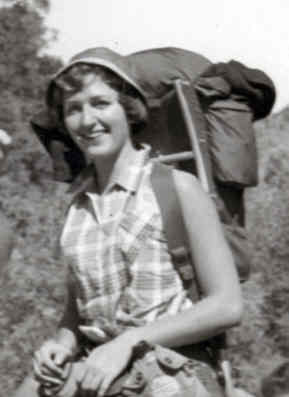 Pat Meixner in a publicity Pat Meixner in a publicity
photo
for Kelty Packs
|
|
Frank Bressel and Pat Meixner took
a group to Mt. Silliman, between Giant Forest and Kings Canyon, on Sept. 8-9.
Bud Bingham and Don Clarke, leading a rugged trip over Taboose Pass to Cardinal
Mountain on Sept. l5-16, were clobbered by an early-season snowstorm, but made
the peak anyway under very adverse conditions. Mt. Morrison, overlooking
Convict Lake, is one of the few Sierra peaks that can be done in one day
without knapsacking. Miles Brubacher and Izzy Lieberman led a pleasant but
steep climb of it on Sept. 22-23. George Wallerstein and Bud Bingham led a
group from Whitney Portal around Tulainyo Lake (highest in North America) to
Tunnabora Peak on Sept. 29-30.
|
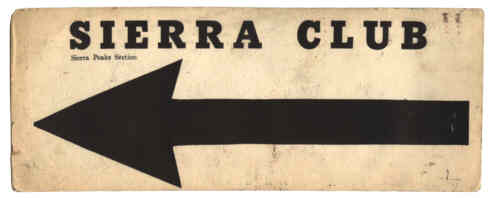
Sample of arrows widely used by SPS
leaders in the 1960's to
direct participants to roadheads. Courtesy of
Jerry Keating |
John
Robinson was to lead
a group from Onion
Valley over Kearsarge
Pass to Mt. Rixford
on Oct. 6-7. Heavy
snow prevented this,
but an attempt was
made on University
Peak. A severe blizzard
forced intrepid climbers
off the steep northeast
ridge of University,
so
that weekend was a
loss.
On Oct.20-21, the section joined the
Desert Peakers in a joint climb of strenuous Peak 11,107, north of Mt. Keynot
on the crest of the Inyo Range. John Robinson, Bud Bingham and Bob Bear
spearheaded this group, which named the peak Mt. Inyo. This name has since
become official. The final SPS-scheduled trip of 1956 was to the southernmost
qualifying peak, 8,475-foot Owens Peak. It was led by Miles Brubacher and Pat
Meixner on Nov. 11. Here again, no knapsacking was necessary.
|
|
All of the mentioned trips into the
Sierra were officially scheduled activities, entered in the schedule books of
the Angeles Chapter of the Sierra Club. When it is remembered that the average
number of trips scheduled by the Angeles Chapter (usually by the Desert Peaks
Section) into the Sierra used to be only three annually, it can readily be
appreciated that the SPS in 1956, fulfilled its mission of scheduling many
trips. This set the pattern for succeeding years. In addition, the trips
extended from early May to early November, putting to rest the old notion that
the Sierra was accessible only from the Fourth of July to the end of September.
Now Sierra Peaks groups are active virtually all year in the Sierra, falling
back upon the southern areas in the winter.
It was decided
at the November,
1956, meeting
to begin publication of a
newspaper for the section,
keeping its
members informed
of what each
was doing, providing information
on future
trips, and giving writeups
of past trips, both scheduled
and non-scheduled. Roger
Gaefcke suggested the name
Sierra Echo for the paper,
and this was unanimously
adopted. Its editorship was
undertaken by John Robinson,
who turned out the Echo
every three
months in Mimeograph form
[actually, Ditto spirit duplicator
form-Ed.]. With the appearance
of the first Echo in February,
1957, this history is
terminated.
The Echo carries the SPS
record beyond that point.
Retrieved
from The Sierra
Echo Vol.
III, No. 2
(May-June
1959). Article
courtesy
of Jerry Keating |






 Pat Meixner in a publicity
Pat Meixner in a publicity 
